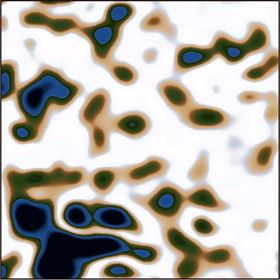 This image shows a bulk single crystal of Sr3Ir2O7, to which the researchers added lanthanum as a partial substitute for strontium in order to bring the system close to the antiferromagnetic transition. Image: Boston College.
This image shows a bulk single crystal of Sr3Ir2O7, to which the researchers added lanthanum as a partial substitute for strontium in order to bring the system close to the antiferromagnetic transition. Image: Boston College.Researchers at Boston College have achieved the atomic-scale visualization of temperature-driven spatial changes of magnetic patterns in a Mott insulator. They report their findings in a paper in Science Advances.
Today’s advanced materials are often 'lumpy' at the nanoscale: their electronic and magnetic properties vary on length scales down to a few nanometers, said Ilija Zeljkovic, an associate professor of physics at Boston College, who led the research. This 'inhomogeneity' can be especially pronounced near a phase transition, where the material changes, or transitions, into a different phase of matter.
A particularly intriguing transition involves a non-magnetic material that becomes magnetic, Zeljkovic added. This transition can be achieved by cooling the material to a low temperature, or by tuning its elemental composition. Though significant progress has been made in understanding magnetic materials as a whole, very little is known about the atomic-scale nature of magnetic transitions.
To find out more, the researchers studied a bulk single crystal of the Mott insulator perovskite iridate Sr3Ir2O7. They added lanthanum to this crystal, as a partial substitute for strontium (Sr), to bring the system close to the antiferromagnetic transition.
Antiferromagnetism is an unusual type of magnetism, Zeljkovic said, which occurs when electron spins at neighboring atomic sites are aligned exactly in opposite directions. The researchers used spin-polarized scanning tunneling microscopy (SP-STM) to map the local strength of antiferromagnetic ordering on nanometer length scales.
This revealed a dramatic re-arrangement of magnetic domains with thermal cycling. “For example, some regions of the sample that were magnetic would become non-magnetic, and vice versa, some areas that used to be non-magnetic would become magnetically ordered after thermal cycling,” Zeljkovic said. “We also found that magnetic domains locally ‘avoid’ lanthanum substitutions, and tend to form away from these impurities.”
The researchers employed a statistical analysis method called cluster analysis theory to analyze the size and distribution of the domains, as this can offer insights into whether or not the domains are completely randomly distributed. “We found that the domains are not randomly distributed, which means that electronic correlations, or electron-electron interactions, likely play a significant role in the emergence of domains,” Zeljkovic said.
This work built upon previous research where Zeljkovic and colleagues visualized antiferromagnetic patches, or domains, in a related doped Mott insulator, Sr2IrO4.
“We wanted to investigate what sets the size and the spatial distribution of these domains in Sr3Ir2O7,” Zeljkovic said. “In addition, we set to explore if and how the domains will change if the material is warmed up to become non-magnetic, and cooled back down into its magnetically ordered state.”
Building on these findings, Zeljkovic and his colleagues will now seek to expand this technique to other complex oxides, as well as materials with different types of magnetic states, such as ferromagnetism.
This story is adapted from material from Boston College, with editorial changes made by Materials Today. The views expressed in this article do not necessarily represent those of Elsevier. Link to original source.